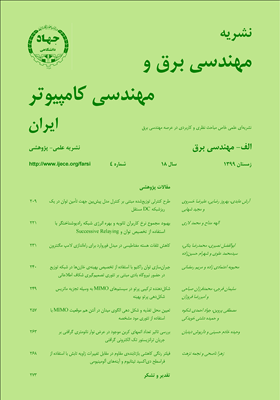شکل دهنده ترکیبی پرتو در سیستم های MIMO به وسیله تجزیه ماتریس شکل دهی پرتو بهینه
محورهای موضوعی : مهندسی برق و کامپیوترمحمدفرزان صباحی 1 * , سلیمان فرجی 2 , امیررضا فروزان 3
1 - دانشگاه اصفهان
2 - دانشگاه اصفهان
3 - دانشگاه اصفهان
کلید واژه: سیستمهای چندورودی- چندخروجیزنجیره RF شکلدهی ترکیبی پرتو,
چکیده مقاله :
سیستمهای چندورودی- چندخروجی (MIMO)، به ویژه سیستمهای MIMO انبوه، با به کار گرفتن تعداد زیاد آنتن بازده طیفی بزرگی به دست میآورند. یک مسئله مهم در این سیستمها شکلدهی پرتو است. اگر شکلدهی پرتو به صورت کاملاً دیجیتال در باند پایه انجام شود، به ازای هر آنتن یک زنجیره RF لازم است که منجر به هزینه و مصرف توان بالا میشود. در شکلدهی پرتو کاملاً آنالوگ، فقط یک زنجیره RF استفاده میشود و الگوی انتشار توسط شیفتدهندههای فاز تنظیم میشود ولی با این روش نمیتوان بازدهی طیفی بهینه را ایجاد کرد. به همین دلیل روشهای ترکیبی آنالوگ- دیجیتال برای شکلدهی پرتو مورد توجه هستند. در این مقاله، یک روش شکلدهی ترکیبی پرتو پیشنهاد میشود که در آن تعداد زنجیره RF مورد نیاز نسبت به حالت کاملاً دیجیتال بسیار کمتر است. طراحی پیشکدگذار و فیلتر گیرنده بر اساس بیشینهکردن بازده طیفی انجام شده است. این هدف در فرستنده، با نزدیککردن حاصلضرب دو ماتریس شکلدهنده پرتو آنالوگ و دیجیتال به ماتریس شکلدهی پرتو بهینه (که حاوی بردارهای منفرد سمت راست ماتریس کانال است) و با یک روش تکراری برآورده میشود. معیار نزدیکبودن دو ماتریس، نرم فروبنیوس تفاضل در نظر گرفته میشود. در گیرنده، طراحی شکلدهنده ترکیبی پرتو به طریق مشابه و با استفاده از معیار کمترین میانگین مربعات خطا انجام میشود. همچنین برای بهبود روش، یک الگوریتم مبتنی بر گرادیان برای کمترکردن خطا پیشنهاد شده است. نتایج شبیهسازی، برتری عملکرد روش پیشنهادی نسبت به روشهای مشابه و همچنین پیچیدگی کمتر آن را نشان میدهد. بسته به سناریوی انتخابی، فاصله بازدهی طیفی روش پیشنهادی با روش بهینه به کمتر از dB 2 میرسد.
MIMO systems, and particularly massive MIMO systems, achieve high spectral efficiency by using a large number of antennas. An important issue in these systems is beamforming. In fully digital baseband beamforming, an RF chain is required for each antenna, which leads to high cost and power consumption. In analog beamforming, only one RF chain is used and beamforming is performed by using phase shifters. This method does not provide optimal spectral efficiency and thus, analog-digital hybrid methods for beamforming are considered. In this paper, a hybrid beamforming method is proposed in which the required number of RF chains is much less than fully digital method. The precoder and receiver filter are designed by maximizing the spectral efficiency. To this end, the optimal beamforming matrix (which contains the right singular vectors of the channel matrix) is approximated by the product of two analog and digital beamforming matrices. This approximation is improved by an iterative method. The criterion for the proximity of the two matrices is considered to be the Frobenius norm of their differences. In the receiver, the design of the hybrid beamforming is performed in a similar way, using the mean squares error criterion. Also, to improve the method, a gradient-based algorithm is proposed to further reduce the error. The simulation results show the performance superiority of the proposed method over similar methods as well as its less complexity.
[1] A. Goldsmith, Wireless Communications, Cambridge University Press, 2005.
[2] L. Lu, et al., "An overview of massive MIMO: benefits and challenges," IEEE J. of Selected Topics in Signal Processing, vol. 8, no. 5, pp. 742-758, Oct. 2014.
[3] B. D. Van Veen and K. M. Buckley, "Beamforming: a versatile approach to spatial filtering," IEEE Assp Magazine, vol. 5, no. 2, pp. 4-24, Apr. 1988.
[4] W. Ni, X. Dong, and W. S. Lu, "Near-optimal hybrid processing for massive MIMO systems via matrix decomposition," IEEE Trans. on Signal Processing, vol. 65, no. 15, pp. 3922-3933, 1 Aug. 2017.
[5] F. Sohrabi and W. Yu, "Hybrid beamforming with finite-resolution phase shifters for large-scale MIMO systems," in Proc. IEEE 16th In. Workshop on Signal Processing Advances in Wireless Communications, SPAWC’15, pp. 136-140, Stockholm, Sweden, 28 June-1 Jul. 2015.
[6] O. El Ayach, S. Rajagopal, S. Abu-Surra, Z. Pi, and R. W. Heath, "Spatially sparse precoding in millimeter wave MIMO systems," IEEE Trans. on Wireless Communications, vol. 13, no. 3, pp. 1499-1513, Mar. 2014.
[7] O. El Ayach, R. W. Heath, S. Abu-Surra, S. Rajagopal, and Z. Pi, "The capacity optimality of beam steering in large millimeter wave MIMO systems," in Proc. IEEE 13th Int. Workshop on Signal Processing Advances in Wireless Communication , SPAWC’12, pp. 100-104, Cesme, Turkey, 17-20 Jun. 2012.
[8] F. Sohrabi and W. Yu, "Hybrid digital and analog beamforming design for large-scale MIMO systems," in Proc. IEEE Int. Conf. on Acoustics, Speech and Signal Processing, ICASSP’15, pp. 2929-2933, South Brisbane, Australia, 19-24 Apr. 2015.
[9] F. Sohrabi and W. Yu, "Hybrid digital and analog beamforming design for large-scale antenna arrays," IEEE J. of Selected Topics in Signal Processing, vol. 10, no. 3, pp. 501-513, Apr. 2016.
[10] S. Payami, Hybrid Beamforming for Massive MIMO Systems, University of Surrey, 2017.
[11] T. E. Bogale, et al., "On the number of RF chains and phase shifters, and scheduling design with hybrid analog-digital beamforming," IEEE Trans. on Wireless Communications, vol. 15, no. 5, pp. 3311-3326, May 2016.

